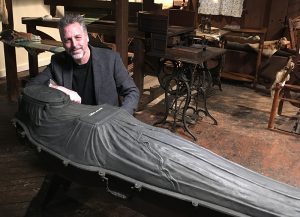“Secrets of the Dead” forensic expert Scott Warnasch to speak at University of Indianapolis Nov. 16


A nationally known forensic archaeologist will share secrets revealed by the discovery of an iron coffin in a talk at the University of Indianapolis Nov. 16.
During “American Mummies: The Industrial Birth of the Eternal Dead,” Scott Warnasch will speak about his most recent episode of “Secrets of the Dead – The Woman in the Iron Coffin” that aired in October 2018 on PBS. The event will be held at 5:00 p.m. in Lilly Performance Hall in the Christel DeHaan Fine Arts Center. A question and answer session will follow the lecture.
Krista Latham, director of the University of Indianapolis Human Identification Center, is organizing the talk. Latham’s work to identify the remains of migrants who died while crossing the southern border has been nationally recognized.
Register here for this free, L/P event.
Warnasch, a consultant who conducts field and lab work in forensic archaeology, will discuss the investigation surrounding the identity of a woman found inside a Fisk iron coffin that was disturbed by construction crews in New York City in 2011. The woman was identified as a descendent of the St. Mark AME (African Methodist Episcopal) Church community, and the discovery shed light on early African-American history and the development of the AME Church.
The iron coffin, which was responsible for the woman’s remarkable level of preservation, was expensive yet very practical during the early years of steam travel. Many historical figures were buried in these coffins; however, in this case the coffin contained an ordinary citizens, Warnasch said, and a well-preserved body can reveal details about the overall health and customs of a particular social group in that historical period.
“The clothing and how they were prepared for burial speak volumes about things that don’t get recorded for everyday people,” Warnasch said. “The people who were represented in these early iron coffins are like time travelers from the beginning of the modern world.”
Originally reported as a potential crime scene, investigators in New York realized they were in fact dealing with an archaeological site more than 150 years old. The deceased was identified as Martha Peterson, who died of smallpox around 1851. Warnasch said the case highlights the expertise that archaeologists can contribute to the forensic field.
“Archaeologists are specifically trained to do exactly the meticulous documentation and step-by-step process of investigation and body recovery that most law enforcement officers are not trained to do,” Warnasch explained.
Warnasch said his mission is to teach people how much more there is to understand about grave investigation than “just grabbing a shovel and getting the body out of the ground. I add a layer of context to that crime scene that other people don’t focus on.”
Warnasch’s professional experience includes leading the human remains recovery operation at Ground Zero in the wake of the World Trade Center attack on September 11th, 2001.
“There were valuable lessons learned on what worked the first time around and what didn’t,” he said. “It proves that archaeological methodology is solid and a vital tool in mass disaster responses.”
While the topic is a favorite of film and television programs like “Bones” and “CSI” as well as a plethora of documentaries, the reality of a thorough investigation is a far cry from the grave-robbing so breezily depicted in “Raiders of the Lost Ark” (which incidentally was released the same summer that Warnasch did his first field school.)
“I don’t do a lot of excavations with a whip!” Warnasch joked. “There’s a method to it. There’s a lot of thought and research that goes on. Context is so important – you have to understand the environment that you’re working in.”
Warnasch hopes to see even more convergence between the fields of crime scene recovery and archaeology. For students interested in pursuing a career in the field, he recommends being “open-minded about what you’re willing to work on. Digging in Europe teaches you things you’d never learn digging in California. To get a well-rounded experience will leave you open to opportunities.”
Learn more about Scott Warnasch
Register here for this free, L/P event.
Written by Sara Galer, Communications Manager, University of Indianapolis. Contact newsdesk@uindy.edu with your campus news.
